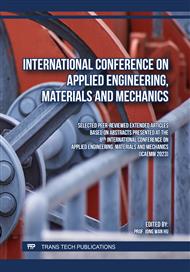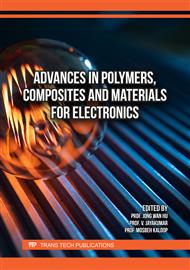[1]
P.O. Oladoye, M.O. Bamigboye, O.D. Ogunbiyi, M.T. Akano, Toxicity and decontamination strategies of Congo red dye, Groundw Sustain Dev. 19 (2022). https://doi.org/10.1016/j.gsd. 2022.100844.
DOI: 10.1016/j.gsd.2022.100844
Google Scholar
[2]
A.K.D. Alsukaibi, Various Approaches for the Detoxification of Toxic Dyes in Wastewater, Processes. 10 (2022).
DOI: 10.3390/pr10101968
Google Scholar
[3]
D. Deng, M. Lamssali, N. Aryal, A. Ofori-Boadu, M.K. Jha, R.E. Samuel, Textiles wastewater treatment technology: A review, Water Environment Research. 92 (2020) 1805–1810.
DOI: 10.1002/wer.1437
Google Scholar
[4]
S.H. Teo, C.H. Ng, A. Islam, G. Abdulkareem-Alsultan, C.G. Joseph, J. Janaun, Y.H. Taufiq-Yap, S. Khandaker, G.J. Islam, H. Znad, M.R. Awual, Sustainable toxic dyes removal with advanced materials for clean water production: A comprehensive review, J Clean Prod. 332 (2022).
DOI: 10.1016/j.jclepro.2021.130039
Google Scholar
[5]
A.N. Amenaghawon, C.L. Anyalewechi, O.U. Osazuwa, E.A. Elimian, S.O. Eshiemogie, P.K. Oyefolu, H.S. Kusuma, A comprehensive review of recent advances in the synthesis and application of metal-organic frameworks (MOFs) for the adsorptive sequestration of pollutants from wastewater, Sep Purif Technol. 311 (2023) 123246.
DOI: 10.1016/j.seppur.2023.123246
Google Scholar
[6]
H. Konno, A. Tsukada, Size- and ion-selective adsorption of organic dyes from aqueous solutions using functionalized UiO-66 frameworks, Colloids Surf a Physicochem Eng Asp. 651 (2022).
DOI: 10.1016/j.colsurfa.2022.129749
Google Scholar
[7]
M. Allahbakhshi, N.M. Mahmoodi, M. Mosaferi, H. Kazemian, H. Aslani, Synthesis of functionalized metal-organic framework metal-organic framework (MIL-53)/Chitosan for removing dye and pharmaceuticals, Surfaces and Interfaces. 35 (2022).
DOI: 10.1016/j.surfin.2022.102471
Google Scholar
[8]
Y. He, X. Hou, Y. Liu, N. Feng, Recent progress in the synthesis, structural diversity and emerging applications of cyclodextrin-based metal-organic frameworks, J Mater Chem B. 7 (2019) 5602–5619.
DOI: 10.1039/c9tb01548e
Google Scholar
[9]
I. Roy, J.F. Stoddart, Cyclodextrin Metal-Organic Frameworks and Their Applications, Acc Chem Res. 54 (2021) 1440–1453.
DOI: 10.1021/acs.accounts.0c00695
Google Scholar
[10]
L. Li, J. Wang, Z. Zhang, Q. Yang, Y. Yang, B. Su, Z. Bao, Q. Ren, Inverse Adsorption Separation of CO2/C2H2 Mixture in Cyclodextrin-Based Metal-Organic Frameworks, ACS Appl Mater Interfaces. 11 (2019) 2543–2550.
DOI: 10.1021/acsami.8b19590
Google Scholar
[11]
L. Chen, D.D. Zhu, G.J. Ji, S. Yuan, J.F. Qian, M.Y. He, Q. Chen, Z.H. Zhang, Efficient adsorption separation of xylene isomers using a facilely fabricated cyclodextrin-based metal–organic framework, Journal of Chemical Technology and Biotechnology. 93 (2018) 2898–2905.
DOI: 10.1002/jctb.5644
Google Scholar
[12]
T.K. Yan, A. Nagai, W. Michida, K. Kusakabe, S.B. Yusup, Crystal Growth of Cyclodextrin-based Metal-organic Framework for Carbon Dioxide Capture and Separation, Procedia Eng. 148 (2016) 30–34.
DOI: 10.1016/j.proeng.2016.06.480
Google Scholar
[13]
C.X. Yang, Y.Z. Zheng, X.P. Yan, γ-Cyclodextrin metal-organic framework for efficient separation of chiral aromatic alcohols, RSC Adv. 7 (2017) 36297–36301.
DOI: 10.1039/c7ra06558b
Google Scholar
[14]
Y. Perez, G. Yu, Feasibility of Cyclodextrin-Potassium Ion Assemblies Synthesis and Its Application in Loading Bio-active Molecules, Philipp J Sci. 149 (2020) 463–468.
DOI: 10.56899/149.02.19
Google Scholar
[15]
Y. Han, W. Liu, J. Huang, S. Qiu, H. Zhong, D. Liu, J. Liu, Cyclodextrin-based metal-organic frameworks (CD-MOFs) in pharmaceutics and biomedicine, Pharmaceutics. 10 (2018).
DOI: 10.3390/pharmaceutics10040271
Google Scholar
[16]
A. Kathuria, T. Harding, R. Auras, M.B. Kivy, Encapsulation of hexanal in bio-based cyclodextrin metal organic framework for extended release, J Incl Phenom Macrocycl Chem. (2021).
DOI: 10.1007/s10847-021-01095-1
Google Scholar
[17]
B. Zhang, J. Huang, K. Liu, Z. Zhou, L. Jiang, Y. Shen, D. Zhao, Biocompatible Cyclodextrin-Based Metal-Organic Frameworks for Long-Term Sustained Release of Fragrances, Ind Eng Chem Res. 58 (2019) 19767–19777.
DOI: 10.1021/acs.iecr.9b04214
Google Scholar
[18]
X. Chen, T. Guo, K. Zhang, J. Chen, C. Wang, X. Ren, Q. Wang, Y. Yang, C. Liu, W. Tan, S. Gui, L. Wu, J. Zhang, Simultaneous improvement to solubility and bioavailability of active natural compound isosteviol using cyclodextrin metal-organic frameworks, Acta Pharm Sin B. (2021).
DOI: 10.1016/j.apsb.2021.04.018
Google Scholar
[19]
V. Singh, T. Guo, H. Xu, L. Wu, J. Gu, C. Wu, R. Gref, J. Zhang, Moisture resistant and biofriendly CD-MOF nanoparticles obtained: Via cholesterol shielding, Chemical Communications. 53 (2017) 9246–9249.
DOI: 10.1039/c7cc03471g
Google Scholar
[20]
D. Ke, J.F. Feng, D. Wu, J.B. Hou, X.Q. Zhang, B.J. Li, S. Zhang, Facile stabilization of a cyclodextrin metal-organic framework under humid environment: Via hydrogen sulfide treatment, RSC Adv. 9 (2019) 18271–18276.
DOI: 10.1039/c9ra03079d
Google Scholar
[21]
S.T. Fan, Z.H. Chen, Z. Yang, J.F. Feng, L.P. Yu, Z.J. Qiu, W.T. Liu, B.J. Li, S. Zhang, Facile preparation of humidity stable green γ-cyclodextrin metal–organic framework monolith for CO2 capture, AIChE Journal. (2022).
DOI: 10.1002/aic.17872
Google Scholar
[22]
H. Li, M.R. Hill, R. Huang, C. Doblin, S. Lim, A.J. Hill, R. Babarao, P. Falcaro, Facile stabilization of cyclodextrin metal-organic frameworks under aqueous conditions via the incorporation of C60 in their matrices, Chemical Communications. 52 (2016) 5973–5976.
DOI: 10.1039/c6cc01620k
Google Scholar
[23]
R.S. Forgan, R.A. Smaldone, J.J. Gassensmith, H. Furukawa, D.B. Cordes, Q. Li, C.E. Wilmer, Y.Y. Botros, R.Q. Snurr, A.M.Z. Slawin, J.F. Stoddart, Nanoporous carbohydrate metal-organic frameworks, J Am Chem Soc. 134 (2012) 406–417.
DOI: 10.1021/ja208224f
Google Scholar
[24]
J.V.D. Perez, E.T. Nadres, H.N. Nguyen, M.L.P. Dalida, D.F. Rodrigues, Response surface methodology as a powerful tool to optimize the synthesis of polymer-based graphene oxide nanocomposites for simultaneous removal of cationic and anionic heavy metal contaminants, RSC Adv. 7 (2017) 18480–18490.
DOI: 10.1039/c7ra00750g
Google Scholar
[25]
P.C. Bandara, J.V.D. Perez, E.T. Nadres, R.G. Nannapaneni, K.J. Krakowiak, D.F. Rodrigues, Graphene Oxide Nanocomposite Hydrogel Beads for Removal of Selenium in Contaminated Water, ACS Appl Polym Mater. 1 (2019) 2668–2679.
DOI: 10.1021/acsapm.9b00612
Google Scholar
[26]
J.E.T. Nolasco, E.N.O. Cañeba, K.M. v Edquila, J.I.C. Espita, J.V.D. Perez, Kinetics and isotherm studies of methyl orange adsorption using polyethyleneimine-graphene oxide polymer nanocomposite beads, Key Eng Mater. 801 KEM (2019) 304–310.
DOI: 10.4028/www.scientific.net/KEM.801.304
Google Scholar
[27]
M.L.K.S.J. Celebre, M.L.P. Dalida, J.V.D. Perez, Response Surface Optimization of Graphene Oxide-Reinforced Dual-Crosslinked Alginate/Poly (Vinyl Alcohol) Hydrogel Beads for Methylene Blue Adsorption, Materials Science Forum. 1005 (2020) 101–107.
DOI: 10.4028/www.scientific.net/MSF.1005.101
Google Scholar
[28]
H. Singh, A. Goyal, S.K. Bhardwaj, M. Khatri, N. Bhardwaj, Highly robust UiO-66@PVDF metal–organic framework beads for tartrazine removal from aqueous solutions, Mater Sci Eng B Solid State Mater Adv Technol. 288 (2023).
DOI: 10.1016/j.mseb.2022.116165
Google Scholar
[29]
A.E.A.A. Nayl, A.I. Abd-Elhamid, W.A.A. Arafa, I.M. Ahmed, A.A. El-Shanshory, M.A. Abu-Saied, H.M.A. Soliman, M.A. Abdelgawad, H.M. Ali, S. Bräse, Chitosan-Functionalized-Graphene Oxide (GO@CS) Beads as an Effective Adsorbent to Remove Cationic Dye from Wastewater, Polymers (Basel). 14 (2022).
DOI: 10.3390/polym14194236
Google Scholar
[30]
R. Soury, M. Jabli, S. Latif, K.M. Alenezi, M. el Oudi, F. Abdulaziz, S. Teka, H. el Moll, A. Haque, Synthesis and characterization of a new meso-tetrakis (2,4,6-trimethylphenyl) porphyrinto) zinc (II) supported sodium alginate gel beads for improved adsorption of methylene blue dye, Int J Biol Macromol. 202 (2022) 161–176.
DOI: 10.1016/j.ijbiomac.2022.01.087
Google Scholar
[31]
G. Viscusi, E. Lamberti, G. Gorrasi, Design of sodium alginate/soybean extract beads loaded with hemp hurd and halloysite as novel and sustainable systems for methylene blue adsorption, Polym Eng Sci. 62 (2022) 129–144.
DOI: 10.1002/pen.25839
Google Scholar
[32]
A. Mokhtar, S. Abdelkrim, A. Djelad, A. Sardi, B. Boukoussa, M. Sassi, A. Bengueddach, Adsorption behavior of cationic and anionic dyes on magadiite-chitosan composite beads, Carbohydr Polym. 229 (2020).
DOI: 10.1016/j.carbpol.2019.115399
Google Scholar
[33]
H. Ni'Mah, D. Puspitasari, A.R. Kurniawan, B. Muiz, A. Roesyadi, F. Kurniawansyah, E.O. Ningrum, Kinetic study of cationic dye adsorption on cellulose acetate butyrate/poly (L-lactic acid) composite beads, in: AIP Conf Proc, American Institute of Physics Inc., 2020.
DOI: 10.1063/1.5140959
Google Scholar
[34]
A. Saha, V. Tripathy, B.B. Basak, J. Kumar, Entrapment of distilled palmarosa (cymbopogon martinii) wastes in alginate beads for adsorptive removal of methylene blue from aqueous solution, Environ Prog Sustain Energy. 37 (2018) 1942–1953. https://doi.org/.
DOI: 10.1002/ep.12872
Google Scholar
[35]
G. Viscusi, E. Lamberti, G. Gorrasi, Design of a hybrid bio-adsorbent based on Sodium Alginate/Halloysite/Hemp hurd for methylene blue dye removal: kinetic studies and mathematical modeling, Colloids Surf a Physicochem Eng Asp. 633 (2022).
DOI: 10.1016/j.colsurfa.2021.127925
Google Scholar



